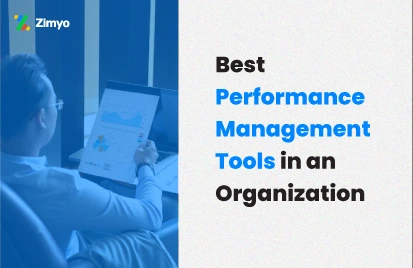“Performance management is not just a tick-the-box activity; it’s a strategic imperative for success.”
In today’s rapidly evolving workplace, effective performance management is more crucial than ever. But what exactly are the objectives of performance management? It goes far beyond the traditional annual evaluations and appraisals. It’s about promoting a culture of continuous improvement. It helps in aligning individual goals with the broader organizational objectives.
Are you wondering why this matters so much? For managers, HR professionals, and decision-makers, understanding these objectives is important to find your team’s full potential. Performance management is the driving force of organizational success.

What is Performance Management?
Before going into the objectives of performance management, let’s first understand what performance management actually means. At its core, performance management is more than just an annual review. It’s a sort of 360-degree approach that covers planning, monitoring, developing, and evaluating employee performance. But why is this important?
For HR professionals and managers, performance management is a dynamic, ongoing process. It extends far beyond traditional appraisal methods. So, what makes it different? It involves setting clear goals, providing regular feedback, and focusing on continuous skill enhancement. The goal of performance management is not just to assess what’s been done in the past. It’s about creating an environment where employees can perform their very best and improve continuously.
Are you wondering how this fits into your current HRM practices? Consider how performance management software can streamline these processes. With the right HRMS tools, you can set up a system that aligns individual goals with strategic objectives, monitors progress in real time, and offers development opportunities customized to each employee.
Why Use Performance Management Software?
Have you considered how much easier it is to manage performance with the right tools? A good performance management software automates the process. It provides real-time data. This way it allows managers to give timely feedback and make informed decisions.
But that’s not all. The aim of performance management is also to reduce biases in appraisals. How does performance management software help? By offering objective criteria, consistent evaluation methods, and comprehensive reporting tools, your HRM system ensures fairness across the board.
Performance Management Objectives
What are the core objectives of performance management? Before diving into these key aspects, let’s remember that performance management is more than just a set of processes. It’s a dynamic, holistic approach that aims to align individual efforts with organizational success. How can we achieve this? By setting clear goals, through open communication, ensuring fair evaluations, facilitating development, and seeking continuous feedback. Let’s explore these objectives in more detail.
1. Setting Clear Goals
First and foremost, the goal of performance management is to establish clear, measurable objectives. But why is this so crucial? Because clear goals provide direction and purpose, both for individuals and the organization as a whole. Are you setting specific and achievable goals for your team? Here’s how you can ensure your performance management objectives are on point:
- Be Specific: Vague goals lead to vague results. For instance, instead of saying “increase sales,” set a target like “increase sales revenue by 30% within the next quarter.”
- Ensure Alignment: The aim of performance management is to connect individual goals with the company’s broader strategy.
- Follow SMART Criteria: Use the SMART framework—Specific, Measurable, Achievable, Relevant, and Time-bound. This ensures clarity and accountability.
- Review Regularly: Goals should evolve with changing circumstances. Are you regularly reviewing and adjusting them as needed? An efficient performance management software can help with that.
2. Open Communication
Effective communication is the backbone of any successful organization. But how do you ensure it happens? The aim of performance management is to create channels for regular feedback and open dialogue between managers and employees. Here are some ways to enhance communication in your performance management strategy:
- Regular Check-ins: Schedule one-on-one meetings to discuss progress, address concerns, and provide feedback.
- Encourage Open Dialogue: Promote a culture where employees feel comfortable sharing their ideas and challenges.
- Use Technology: Use performance management software and other tools so that your employees can communicate openly. Whether it’s project management or collaboration platforms, technology can make information sharing easier.
- Provide Training: Equip your managers with the skills they need for effective communication. Are they trained in active listening and giving constructive feedback?
3. Ensuring Fair & Transparent Evaluation
Fairness and transparency are non-negotiable when it comes to performance evaluations. But how do you ensure this in your performance management process? The goal of performance management is to create a fair and objective system for assessing employee performance. Consider these strategies:
- Clear Evaluation Criteria: Communicate the criteria for assessments clearly. Are your employees aware of what’s expected?
- Training for Evaluators: Ensure that managers are trained to conduct unbiased assessments. Is your performance management software equipped to track this?
- Self-Evaluations: Encourage employees to assess their own performance. How does this fit into your overall performance management strategy?
4. Facilitating Employee Development
Performance management isn’t just about looking back—it’s about planning for the future. How are you linking performance assessments with development plans? The aim of performance management is to make sure that employees have all the necessary resources they need to grow. Here’s how you can support employee development:
- Regular Skill Assessments: Identify existing skills and areas for improvement. Are you doing this consistently?
- Customized Training Opportunities: Offer training that aligns with individual career goals. We suggest you utilize an effective performance management software to track these opportunities.
- Individual Development Plans: Collaborate with employees to create development plans. Integrate these plans into your HRMS.
5. Seeking Continuous Feedback
Continuous feedback is important for growth and development. But how do you ensure that it’s happening regularly? The goal of performance management is to create a culture where feedback is ongoing, not just an annual event. Here’s how you can make continuous feedback a reality:
- Regularly Scheduled Check-Ins: Set up a consistent schedule for one-on-one meetings. A proficient performance management software can help you maintain this routine.
- Balanced Feedback: Provide a mix of positive and constructive feedback. Try to balance these in your conversations with the employees.
- Doing Self-Reflection: Encourage employees to reflect on their performance. Tell them to come prepared with insights and questions during feedback sessions.
Conclusion
In conclusion, the objectives of performance management are multifaceted and essential for driving organizational success. By choosing a standardized performance management software and aligning it with your HRMS, you can ensure that these objectives are met effectively.
Zimyo Performance Management Software
Ready to upgrade your performance management strategy? With Zimyo, the best performance management software out there, you can easily align your team’s goals, carry out open communication, and ensure fair evaluations—all in one platform. Help your organization reach success by creating a culture of continuous improvement and growth. Don’t wait—take the first step towards a smarter, more efficient performance management process today.




